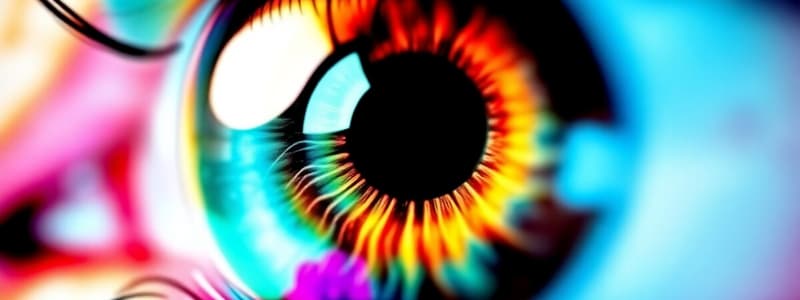Podcast
Questions and Answers
How does the eye adjust to focus on a near object compared to a far object?
How does the eye adjust to focus on a near object compared to a far object?
- The ciliary muscles relax, the zonule fibers relax, and the lens becomes thinner.
- The ciliary muscles contract, the zonule fibers relax, and the lens becomes rounded. (correct)
- The ciliary muscles contract, the zonule fibers relax, and the lens becomes thinner.
- The ciliary muscles relax, the zonule fibers become taut, and the lens becomes rounded.
What is the state of the eye lens when focusing on far objects?
What is the state of the eye lens when focusing on far objects?
- Thicker and more powerful due to contracted eye muscles.
- Its shape is not influenced by the distance of the viewed object.
- Rounded due to the relaxed state of the zonule fibers.
- Flattened and less powerful due to taut zonule fibers. (correct)
If an individual is having difficulty seeing distant objects clearly, which of the following describes the likely adjustment their eye is unable to make effectively?
If an individual is having difficulty seeing distant objects clearly, which of the following describes the likely adjustment their eye is unable to make effectively?
- The ciliary muscles are unable to contract sufficiently.
- The eye lens is becoming thicker than normal
- The eye lens is unable to flatten adequately. (correct)
- The zonule fibers are unable to relax adequately.
How does the image formed on the retina relate to the actual orientation of the object being viewed?
How does the image formed on the retina relate to the actual orientation of the object being viewed?
Imagine a scenario where the zonule fibers of the eye are permanently damaged and unable to change tension. What would be the most likely consequence?
Imagine a scenario where the zonule fibers of the eye are permanently damaged and unable to change tension. What would be the most likely consequence?
Flashcards
Image Orientation on Retina
Image Orientation on Retina
The image formed on the retina is upside down.
Focusing on Near Objects
Focusing on Near Objects
When viewing near objects, the ciliary muscle contracts, the zonule fibers relax, and the lens becomes more rounded to increase its refractive power.
Focusing on Far Objects
Focusing on Far Objects
When viewing distant objects, the ciliary muscle relaxes, the zonule fibers become taut, and the lens flattens to decrease refractive power.
Eye Muscles for Close Objects
Eye Muscles for Close Objects
Signup and view all the flashcards
Eye Muscles for Distant Objects
Eye Muscles for Distant Objects
Signup and view all the flashcards
Study Notes
- The eye forms an inverted image on the retina.
Focusing on Near Objects
- Light rays from close objects diverge.
- To focus on near objects, eye muscles contract, making the lens thicker and more powerful.
- The ciliary muscle is contracted.
- The zonule fibers are relaxed.
- The lens becomes rounded.
Focusing on Far Objects
- Light rays from distant objects are nearly parallel.
- To focus on distant objects, eye muscles relax, causing the lens to become thin and less powerful.
- The ciliary muscle is relaxed.
- The zonule fibers are taut.
- The lens is flattened.
Studying That Suits You
Use AI to generate personalized quizzes and flashcards to suit your learning preferences.




